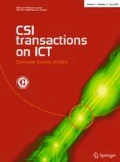Abstract
Agriculture is of high importance in India because of the dependence of 140 million farmers on the sector, its implications for a climate smart future, as a supplier of raw materials for industries, and for feeding the large population. Information becomes an important input in the sector to make it sustainable and social media is an important tool. Acceptance and use of social media is skewed across the sector because of multiple factors that ultimately decide its applicability. This study explored social media usage among agricultural extension professionals and their perceived benefits for agricultural development. The study draws data collected through online Google forms distributed through email and social media platforms (Facebook, Twitter, WhatsApp) from 269 extension professionals globally and 264 from India and discusses what affects use of social media in professional communication. WhatsApp, Facebook and YouTube were the most preferred platforms because of easier user interface and higher percentage of users, and personal mobile phones were the most preferred mode of access. Organizations were found to be catching up in use of social media but still lagged behind in concrete policies to guide the use of digital tools. The findings strongly advocate increased use of social media in agricultural extension and advisory services.


Similar content being viewed by others
Notes
Difference in level of education of the average population between the economies.
The increasing phenomena of forwarding messages on social media as received, without fact checking of any kind, snowballs the chances of spreading information that lacks authenticity, and may provide wrong information in cases, thus causing negative impacts.
References
McNab C (2009) What social media offers to health professionals and citizens. Bull World Health Organ 2009(87):566–566. https://doi.org/10.2471/BLT.09.066712
Brown K (2017) 9 Ways social media is transforming developing countries. http://dobusinessjamaica.com/blog/9-ways-social-media-is-transforming-developing-countries/. Accessed 22 May 2018
Kemp S (2018) Digital in 2018: World’s internet users pass the 4 billion mark. https://wearesocial.com/blog/2018/01/global-digital-report-2018. Accessed 22 May 2018
Smith R (2018) A million WhatsApp messages were sent in the time it’s taken you to read this headline, World Economic Forum. https://www.weforum.org/agenda/2018/03/internet-minute-whatsapp-facebook-emails/. Accessed 9 April 2018
Mitchell A, Simmons K, Matsa KE, Silver L (2018) People in poorer countries just as likely to use social media for news as those in wealthier countries. http://www.pewglobal.org/2018/01/11/people-in-poorer-countries-just-as-likely-to-use-social-media-for-news-as-those-in-wealthier-countries/. Accessed 22 May 2018
Global NGO Technology Report (2018) http://www.nptechforgood.com/2018/02/11/2018_global_ngo_technology_report/. Accessed 22 May 2018
Global Diffusion of eHealth: Making Universal Health Coverage Achievable (2016) Report of the third global survey on eHealth. Geneva: World Health Organization; 2016. Licence: CC BY-NC-SA 3.0 IGO. http://apps.who.int/iris/bitstream/handle/10665/252529/9789241511780-eng.pdf;jsessionid=8BC7D48D5A1AF7B1491BC2E9CD8BC3D0?sequence=1. Accessed 20 May 2018
Jurgenson N (2012) When atoms meet bits: social media, the mobile web and augmented revolution. Future Internet 4:83–91
Schivinski B, Christodoulides G, Dabrowski D (2016) Measuring consumers’ engagement with brand-related social-media content—development and validation of a scale that identifies levels of social-media engagement with brands. J Advert Res 56(1):1–18. https://doi.org/10.2501/JAR-2016-000
Schivinski B, Dabrowski D (2014) The effect of social media communication on consumer perceptions of brands. J Mark Commun (ahead of print). https://doi.org/10.1080/13527266.2013.871323
Bruhn M, Schoenmueller V, Schäfer DB (2012) Are social media replacing traditional media in terms of brand equity creation? Manag Res Rev 35(9):770–790
Laroche M, Habibi MR, Richard MO, Sankaranarayanan R (2012) The effects of social media based brand communities on brand community markers, value creation practices, brand trust and brand loyalty. Comput Hum Behav 28(5):1755–1767
Schau HJ, Muniz JRAM, Arnould EJ (2009) How brand community practices create value. J Mark 73:30–51
Algesheimer R, Dholakia UM, Herrmann A (2005) The social influence of brand community: evidence from European car clubs. J Mark 69(July):19–34
Suchiradipta B, Saravanan R (2016) Social media: shaping the future of agricultural extension and advisory services, GFRAS interest group on ICT4RAS discussion paper. GFRAS, Lindau
Nelson GC, Rosegrant MW, Koo J, Robertson R, Sulser T, Zhu T, Ringler C, Msangi S, Palazzo A, Batka M, Magalhaes M, Valmonte-Santos R, Ewing M, Lee D (2009) Climate change: impact on agriculture and cost of adaptation. Food Policy Report, IFPRI, Washington DC
Rosenberg T (2014) A Green revolution, this time for Africa, The New York Times. http://opinionator.blogs.nytimes.com/2014/04/09/a-green-revolution-this-time-for-africa/?_r=0. Accessed 10 May 2018
FAO (2015) A body of evidence: what climate change implies for global food security and trade, http://www.fao.org/news/story/en/item/293954/icode/. Accessed 10 May 2018
Woods K, Langcuster JC (2014) The use of digital technology in extension. J Ext. Article5COM3, http://www.joe.org/joe/2014october/comm3.php
Carr CT, Hayes RA (2015) Social media: defining developing and divining. Atl J Commun. https://doi.org/10.1080/15456870.2015.972282
Varner J (2012) Agriculture and social media. Mississippi State University Extension Service, Mississippi
Arnold S, Hill A, Bailey N, Meyers C, (2012) Extension’s online presence: are land grant universities promoting the tripartite mission? J Ext. Article number 6RIB1
Saravanan R, Suchiradipta B (2014) Social media: New generation tools for agricultural extension? http://www.aesa-gfras.net/Resources/file/Saravanan%20Final%20blog%2042.pdf
Kinsley J (2010) Five social media tools for the extension toolbox. J Ex. Article number 5TOT7
Gharis LW, Bardon RE, Evans JL, Hubbard WG, Taylor E (2014) Expanding the reach of extension through social media. J Ext 52(3):1–11
Newman N, Fletcher R, Kalogeropoulos A, Levy DAL, Nielsen RK (2017) Digital News Report 2017, Reuters Institute for the Study of Journalism. https://reutersinstitute.politics.ox.ac.uk/sites/default/files/Digital%20News%20Report%202017%20web_0.pdf. Accessed 20 May 2018
Chowdhury A, Hambly Odame H (2013) Social media for enhancing innovation in agri-food and rural development: current dynamics in Ontario, Canada. J Rural Community Dev 8(2):97–119
Daily time spent on social networking by internet users worldwide from 2012 to 2017 (in minutes). https://www.statista.com/statistics/433871/daily-social-media-usage-worldwide/. Accessed 20 May 2018
Langer E (2014) What’s trending? Social media and its effect on organizational communication. J Undergrad Res. http://www.uwlax.edu/urc/JUR-online/PDF/2014/Langer.Emily.CST.pdf. Accessed 22 May 2018
Pedrick C (2015) Embracing Web 2.0 and Social Media: a life changing pathway for agricultural development actors. CTA, Netherlands. https://publications.cta.int/en/publications/publication/1816/. Accessed 22 May 2018
Author information
Authors and Affiliations
Corresponding author
Rights and permissions
About this article
Cite this article
Suchiradipta, B., Raj, S. The online culture of agriculture: exploring social media readiness of agricultural professionals. CSIT 6, 289–299 (2018). https://doi.org/10.1007/s40012-018-0205-0
Received:
Accepted:
Published:
Issue Date:
DOI: https://doi.org/10.1007/s40012-018-0205-0




